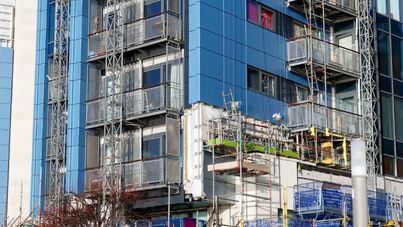Author
The Grenfell Tower fire tragedy in June 2017 raised awareness about the fire safety risk of cladding in buildings, particularly high-rise blocks of residential flats, following which the Ministry of Housing, Communities and Local Government established the Building Safety Programme. Following on from this, the Building Safety Act (BSA) 2022 received Royal Assent in April 2022 with some new law provisions coming into effect on 28 June 2022 and elements which require secondary legislation being introduced during the subsequent period of 18 months.
The BSA 2022 is a major piece of legislation, dealing entirely with building safety and with the intention of creating a unified system for all building control professionals. There are statutory controls on who can develop future blocks of flats and how they should be managed, and a new office of Building Safety Regulator (part of the Health and Safety Executive) has been set up to control how developments are checked and approved. The overall aim of the BSA 2022 is to reduce the number of severe injuries and deaths that arise from building safety issues, though it also provides for new warranty requirements and gives the regulator specific powers, including the ability to levy fines and to require non-compliant work to be stopped and rectified.
There is a particular emphasis on tall residential buildings and the regulator will apply new regulations relating to how these types of buildings are designed, developed and constructed. A new planning gateway regime will also apply, however, the scope is much wider than that and oversees safety and performance for all forms of building projects: this will involve overseeing the general building control systems, advising on safety risks and changes to Building Regulations.
The first provisions which came into effect last year, however, do not relate to future development, but to the recovery of losses caused by building and product defects. The previous six-year limitation period (or 12 where the agreement was executed as a deed) for claims arising before 28 June 2022 has now been significantly extended to 30 years, and for claims arising after that date the period is 15 years.
Part 5 of the BSA 2022 defines how liability will be decided. In simple terms, if:
- the property is a Relevant Building (one which is (with some exclusions) a self-contained building, or part of building, located in England, which contains at least two dwellings and is either at least 11 metres high or has at least five-storeys); and
- the property is subject to a qualifying lease (a long lease of a single dwelling granted before 14 February 2022 which is subject to a service charge and which is/was either the tenant’s principal home or one of no more than three properties owned by them); and
- there are relevant defects (those which are the result of anything which was or wasn’t done or used in the construction or conversion of the building) which caused a building safety risk (a risk to the safety of people arising from fire and/or the collapse of the building); and
- the relevant defects arose during the previous 15 or 30 years (as applicable, see above)
there may be liability on the part of the landlord, developer and/or associated individuals.
In addition to defects, the BSA 2022 has provisions to deal with construction products This means that a party who fails to comply with a construction product requirement, makes a misleading statement in relation to the marketing or supply of a construction product and/or manufactures a construction product which is inherently defective will be liable to pay affected tenants’ damages for personal injury, property damage or economic loss.
The BSA 2022 also extends rights for claims made for dwellings unfit for habitation under the Defective Premises Act 1972 so that claims may now be made against those responsible not just for new work, but also to renovations and refurbishments, with the same extended time limits referred to above. Furthermore, where a private individual suffers harm due to work on a building not meeting Building Regulations’ requirements, extended rights will apply under the Building Act 1984, though such claims will have a limitation period of 15 years no matter when the harm occurred.
With regard to the majority of existing residential leases for Higher Risk Buildings (those over 18 metres in height or with at least seven storeys), the BSA 2022 implies the following covenants into those leases by making amendments to the Landlord & Tenant Act 1985:
- Where the landlord is also the person responsible for the building safety risks, it must comply with the building safety duties. Where someone else is responsible, the landlord must co-operate with them and comply with any special measures order which is in place.
- The tenant is to allow entry to the person responsible for the building safety risks for any reason relating to the safety of the building and comply with any request for information from that person. Furthermore, the tenant must not act in a way that creates a significant risk of a building safety risk materialising, nor interfere with safety equipment in the common parts of the building.
The Landlord & Tenant Act 1987 is amended by the BSA 2022 to require landlords of such buildings to provide each tenant with a notice containing building safety information and to include building safety information in every demand for rent or service charge.
Furthermore, in respect of qualifying residential leases for Relevant Buildings, the BSA 2022 separates the expense of removing any part of an unsafe cladding system which forms the outer wall of an external wall system from other remediation works and the cost of such cannot be recovered from the tenants. However, the BSA 2022 does allow the landlord to recover expenses incurred in respect of non-cladding defects (subject to certain restrictions as set out in Schedule 8) and ongoing safety measures as part of the annual service charge.
Additional provisions contained in the BSA 2022 are:
- An obligation for developers of new homes to provide purchasers with new home warranties which last for 15 years.
- A New Homes Ombudsman Scheme to provide common systems with regard to the sale and handover of new housing and as a means for redress where housing defects are encountered.
- New law-regulated construction products, expanding the approximately 400 current product categories to all construction products marked in the UK.
- Provision for the creation of new civil penalties and criminal sanctions for breaches of the new product laws.
- Powers for the Architect’s Registration Board to remove from the profession architects who are responsible for professional misconduct or serious professional incompetence.
The scale of what the Building Safety Act 2022 is seeking to cover is indeed immense and will have a major impact on all parts of the construction sector.
Print article


